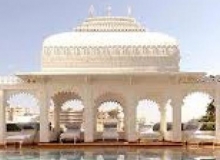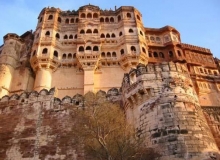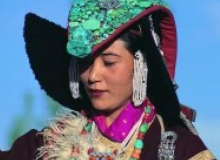
Speak to a specialist
0208 777 4873
0208 777 4873
Places To See: North India
.jpg)
DELHI
Red Fort
Humayun's Tomb
Qutab Minar
India Gate
Rajghat
Parliament House
Rashtrapati Bhavan
Akshardham Temple
Delhi Haat
Chandni Chowk
.jpg)
JAIPUR
Amber Fort
Hawa Mahal
Jantar Mantar
Samode
Johari Bazaar
City Palace
Hawa Mahal
Jantar Mantar
Samode
Johari Bazaar
City Palace

UDAIPUR
Lake Palace Hotel
Shilpgram - Rajastani Handicrafts
Chittorgarh
Lake Pichola
Shilpgram - Rajastani Handicrafts
Chittorgarh
Lake Pichola
AGRA
Taj Mahal
Agra Fort
Jehangir's Palace
Fatehpur Sikri
Agra Fort
Jehangir's Palace
Fatehpur Sikri

JODHPUR
Jodhpur is set at the edge of the Thar Desert. This imperial city echoes with tales of antiquity in the emptiness of the desert. In the past, it was the capital of the Marwar state, founded in 1459 A.D. by Rao Jodha - the chief of the Rathore clan of Rajputs. A high wall -10 km long with 8 gates and innumerable bastions encompasses the city. It was once a major trade center. Jodhpur is now the second largest city of Rajasthan.
Regarding the Jodhpur culture, the Jodhpuri people are amongst the most hospitable people of India. They have a typical Marwari accent. The lifestyle in Jodhpur, India is quite fascinating. The folks there wear nice and lovely multihued costumes. The women folk wear wide gathered skirts and a hip length jacket, with three quarter length sleeves, covering the front and back. Women are also love to wear jewelry on many parts of their body. Another one of the unique features of the culture of Jodhpur, Rajasthan is the colorful turbans worn by men. The popular tight, horse riding trousers, 'Jodhpurs', took their name from this city only. The main languages spoken here are Hindi, Marwari and Rajasthani.
The graceful palaces, forts and temples strewn throughout the city bring alive the historic grandeur of this city. Lending a romantic aura to Jodhpur, are its exquisite handicrafts, folk dances, folk music and the brightly attired people. The desert people are quite affable. With their sweet smiles and warm hospitality, they win the hearts of the tourists. The famous Marwar festival brings out the festive spirits of the people of this city. The bazaars of Jodhpur have a range of items from tie & dye textiles, embroidered leather shoes, lacquerware, antiques, carpets and puppets to the exquisite Rajasthani textiles, clay figurines, miniature camels and elephants, marble inlay work and classic silver jewellery.
Meherangarh Fort
Old City
Old City
Bishnoi Tribal Villages

JAISALMER
The Thar Desert
Forts
Havelis
Traditional Villages of Amarsagar
Forts
Havelis
Traditional Villages of Amarsagar

SAWAI MADHOPUR/ RANTHAMBORE
Tiger Reserve Ranthambhor National Park, once a princely game conserve is the scene where the celebrated Indian tigers are best seen. Ranthambhor Tiger Reserve lies on the junction of Aravali and Vindhyas just 14 Kms from Sawai Madhopur in Eastern Rajasthan. It sprawls over a varying and undulating landscape.
The tiger is not the only attraction at Ranthambhor; although it is the one park resident people come to see. We were lucky to see several varieties of birds including these owlets peering through their burrows pictured here on the right and of course the ubiquitous langur monkey. Other animals in the reserve include leopard, caracal, hyena, jackal, jungle cat, marsh crocodiles, wild boar, bears and various species of deer.
The main food source for the tiger is the swamp deer like Barasinsga and on occasion the wild buffalo and also wild boar.
Park Season: Opened During- 1st October to 30th June
Visiting Shifts- Morning and Afternoon trips
Closed During- 1st July to 30th September
The tiger is not the only attraction at Ranthambhor; although it is the one park resident people come to see. We were lucky to see several varieties of birds including these owlets peering through their burrows pictured here on the right and of course the ubiquitous langur monkey. Other animals in the reserve include leopard, caracal, hyena, jackal, jungle cat, marsh crocodiles, wild boar, bears and various species of deer.
The main food source for the tiger is the swamp deer like Barasinsga and on occasion the wild buffalo and also wild boar.
Park Season: Opened During- 1st October to 30th June
Visiting Shifts- Morning and Afternoon trips
Closed During- 1st July to 30th September

AMRITSAR
Amritsar, literally a Pool of Nectar, derives its name from Amrit Sarovar, the holy tank that surrounds the splendid Golden Temple. Guru Ramdas, the fourth Guru of the Sikh faith, founded Amritsar in 1579. He constructed a pool on land gifted by the Mughal Emperor Akbar and called it Amritsar.
Home to the world famous Golden Temple, the 400-year-old city of Amritsar is the most important seat of Sikh history and culture.
One of the most poignant memorials of free India -- Jallianwala Bagh – is also located in the city. Amritsar district was once a part of the vast area covered by the Indus valley Civilisation during the early period of history.
Home to the world famous Golden Temple, the 400-year-old city of Amritsar is the most important seat of Sikh history and culture.
One of the most poignant memorials of free India -- Jallianwala Bagh – is also located in the city. Amritsar district was once a part of the vast area covered by the Indus valley Civilisation during the early period of history.
Access:
The Rajasansi airport, about 11 km from city centre, is connected by domestic flights to Delhi, Srinagar and Chandigarh.
Amritsar is connected by rail with major cities in India.
Amritsar is connected by rail with major cities in India.
Sights to See
Golden Temple
Also known as Harmandir or Darbar Sahib, the temple is a white and gold majestic building, the foundation of which was laid by the Muslim saint, Mian Mir, an admirer and friend of Guru Arjun. The Mandir is built on a 67-ft square of marble and is a two storied structure. The top structure of the temple is covered with pure gold leaf, hence, the popular name, Golden Temple. Inside the temple lies the holy book of the Sikhs - the Granth Sahib.
More...
Durgiana Temple
A Durga Temple near the Golden temple founded by one of the greatest reformers and political leaders of resurgent India, Pandit Madan Mohan Malviya.
Akal Takht
Adjacent to the Golden Temple, Akal Takht, the supreme seat of Sikh religious authority was established by the sixth Sikh guru, Guru Hargobind (1606-1645). The Akal Takht also houses the ancient weapons used by the Sikh warriors.
Baba Atal Rai Tower
This octagonal, nine-storeyed tower located south of the Golden temple, represents the nine years of life of Atal Rai, son of the sixth Guru Hargobindji. The inner walls are decorated with frescoes on the life of Guru Nanak. The Adi Granth is enshrined within.
Central Sikh Musuem
The museum located atop the Tower of Baba Atal houses some fine old paintings of battles fought by the Sikhs, old manuscripts, coins and weapons.
Jallianwala Bagh
Among the most poignant memorials of free India is Amritsar's Jallianwala Bagh. On April 13, 1919, British General O'Dyer opened fire on a group of people attending a peaceful freedom movement meeting being held here.
Golden Temple
Also known as Harmandir or Darbar Sahib, the temple is a white and gold majestic building, the foundation of which was laid by the Muslim saint, Mian Mir, an admirer and friend of Guru Arjun. The Mandir is built on a 67-ft square of marble and is a two storied structure. The top structure of the temple is covered with pure gold leaf, hence, the popular name, Golden Temple. Inside the temple lies the holy book of the Sikhs - the Granth Sahib.
More...
Durgiana Temple
A Durga Temple near the Golden temple founded by one of the greatest reformers and political leaders of resurgent India, Pandit Madan Mohan Malviya.
Akal Takht
Adjacent to the Golden Temple, Akal Takht, the supreme seat of Sikh religious authority was established by the sixth Sikh guru, Guru Hargobind (1606-1645). The Akal Takht also houses the ancient weapons used by the Sikh warriors.
Baba Atal Rai Tower
This octagonal, nine-storeyed tower located south of the Golden temple, represents the nine years of life of Atal Rai, son of the sixth Guru Hargobindji. The inner walls are decorated with frescoes on the life of Guru Nanak. The Adi Granth is enshrined within.
Central Sikh Musuem
The museum located atop the Tower of Baba Atal houses some fine old paintings of battles fought by the Sikhs, old manuscripts, coins and weapons.
Jallianwala Bagh
Among the most poignant memorials of free India is Amritsar's Jallianwala Bagh. On April 13, 1919, British General O'Dyer opened fire on a group of people attending a peaceful freedom movement meeting being held here.
Customs
You should remain aware and respectful of the Sikh religion anywhere near the Golden Temple complex.
Inside the complex both men and women are required to cover their heads (scarves are widely available throughout the town for Rs 10, or a box of them are free to use at the entrances to the temple).
Smoking and alcohol are forbidden within the complex and anywhere within sight of the temple. Lighting up a cigarette on the busy street out front will definitely attract negative attention, as will spitting near the temple.
Photography is allowed on the outside ring of the holy lake, but not inside the actual temple itself.
Best time to visit Amritsar is in the winter, between October and March
Inside the complex both men and women are required to cover their heads (scarves are widely available throughout the town for Rs 10, or a box of them are free to use at the entrances to the temple).
Smoking and alcohol are forbidden within the complex and anywhere within sight of the temple. Lighting up a cigarette on the busy street out front will definitely attract negative attention, as will spitting near the temple.
Photography is allowed on the outside ring of the holy lake, but not inside the actual temple itself.
Best time to visit Amritsar is in the winter, between October and March

LADAKH
Ladakh rests between the two highest mountain ranges the Himalayas and the Karakoram, a part of Jammu and Kashmir. It consists of Leh and Kargil. In spite of its extreme cold climate Ladakh has always fascinated people form all over the world. Winters which are bitterly cold in Ladakh can fall as low as – 45 degrees c, but the beauty and magic of Ladakh lays in the fact that even today it is untouched by the crowded city life and remains one of the most unexplored areas of the world.
The barren beauty of Ladakh with snow capped peaks and clean azure sky have attracted the intrepid traveler since the region was opened to tourists in the 1970s. Since then, Ladakh has become a favorite haunt for trekking and mountaineering enthusiasts. The rugged terrain and the majestic mountains around, make an exotic cocktail for an adventure sport lover. But before you decide to fly away to the land of Buddhist monasteries and brave people, it is imperative to understand that you need at least a week to enjoy your tour to Ladakh. Since, acclimatization it self needs at least a few days in Ladakh.
Ladakh is home to a large number of Buddhists, who have preserved their rich culture and tradition from the days of yore. A tour to Ladakh is not just about beautiful views of snow-capped peaks kissing the blue sky or colorful flags flattering in the wind but is also about centuries old culture of Ladakhi people and their indomitable spirit to live cheerfully in one of the most hostile terrains in the world. Ladakh the ‘ethereal cold desert’ has been given many names like The Last Shangri-La, Moonscape and Little Tibet
Leh is the capital of Ladakh and undoubtedly the heart of Ladakh too! Surrounded by mountains on all sides and situated on the banks of River Indus, Leh spells sheer elegance of nature in its raw form. Frequented by trekkers Leh is famous for traditionally clad women carrying baskets on their backs- selling all kinds of articles.
Religion and Culture: Buddhism is the way of life in Ladakh, though there are people of other faiths in Ladakh who live in harmony with each other. The Buddhist monasteries dot the Ladakh landscape and are the center of attraction during the various fairs and festivals.
One can find 'tangkhas', masks, musical instruments and precious items in the Gompas in Ladakh. A huge painting of the Buddha inside the Hemis Monastery is the biggest draw. Thiksey and Shey monasteries are the classic architectural wonder in the region. No matter which part of Ladakh you travel, the smiling Buddha and His followers greet you in smile.
Simplicity is the way of life in Ladakh, as the modernity has not touched the town as it has happened in other cities and towns of India. Cut-off from rest of the world, Ladakh is barren yet beautiful. Ladakh comes alive during the fairs and festivals as one can see Ladakhi people in their traditional dress. Perak, the headgear worn by traditional Ladakhi women is the striking feature of womenfolk of Ladakh. The other feature that strikes are the precious stones that adorn a woman's neck in Ladakh.
Monasteries: In Ladakh, monasteries either belong to Mahayana or Hinayana sect of Buddhism. Hemis is one of the largest and most popular monasteries in Ladakh. The monastery is quiet popular among tourists and most travelers to Ladakh visit the monastery. The Hemis is center of action during the annual Hemis festival that takes place in June-July. The festival is held to commemorate the birth anniversary of Guru Padmasambhava. This is the best time to see the cultural side of Ladakh. During the festival, locals from remote corners of Ladakh converge on the Hemis monastery.
Reaching Ladakh: Leh is the nearest airport, which is connected to Delhi, Chandigarh and Srinagar. The nearest railway station to Ladakh is Jammu. From Jammu you can head to Srinagar by road and then to Ladakh, which is some 434 kilometers away. It is about two-day journey from Srinagar with night halt at Kargil. You can also approach Leh Ladakh from Manali. Discover a new way of life and culture in the Himalayas with Global Explorers.
Trekking and Mountaineering in Ladakh: Leh Ladakh is one of few wonderful destinations ideal for trekking and mountaineering. Ladakh with its rough terrain and wonderful scenic locales offer an adventure lover a mix of both scenic beauty and challenging heights. The Susu and Zanskar valley has a number of stunning peaks that challenge an intrepid traveler to scale new heights in Ladakh. Some of the ideal places for mountaineering include Nun-Kun massif and Zanskar massif. The best time to visit Leh Ladakh is during the months of June and October.
Ladakh is a trekking haven for trekkers. There are a number of trekking trails in Leh Ladakh that passes through many beautiful locations. Spituk to Markha Valley, Laayury gompa to Chilling and Likir to Temisgam are some of the popular treks that one can take. Acclimatization is the most important activity before heading for trekking and mountaineering. Rafting down the Zanskar is another exciting thought but it is imperative to take help of a rafting instructor or guide.
Ever thought of trekking on a frozen river? A part of the Zanskar River freezes during the winter and is used as trekking route by many seasoned trekking enthusiasts. The trek is one of its kinds in Leh Ladakh. If you are a novice when it comes to climbing mountains and negotiating treacherous treks, it is better to hire a seasoned mountaineer or trekker. A guide with experience and with fairly good knowledge of the area is of great help.
The barren beauty of Ladakh with snow capped peaks and clean azure sky have attracted the intrepid traveler since the region was opened to tourists in the 1970s. Since then, Ladakh has become a favorite haunt for trekking and mountaineering enthusiasts. The rugged terrain and the majestic mountains around, make an exotic cocktail for an adventure sport lover. But before you decide to fly away to the land of Buddhist monasteries and brave people, it is imperative to understand that you need at least a week to enjoy your tour to Ladakh. Since, acclimatization it self needs at least a few days in Ladakh.
Ladakh is home to a large number of Buddhists, who have preserved their rich culture and tradition from the days of yore. A tour to Ladakh is not just about beautiful views of snow-capped peaks kissing the blue sky or colorful flags flattering in the wind but is also about centuries old culture of Ladakhi people and their indomitable spirit to live cheerfully in one of the most hostile terrains in the world. Ladakh the ‘ethereal cold desert’ has been given many names like The Last Shangri-La, Moonscape and Little Tibet
Leh is the capital of Ladakh and undoubtedly the heart of Ladakh too! Surrounded by mountains on all sides and situated on the banks of River Indus, Leh spells sheer elegance of nature in its raw form. Frequented by trekkers Leh is famous for traditionally clad women carrying baskets on their backs- selling all kinds of articles.
Religion and Culture: Buddhism is the way of life in Ladakh, though there are people of other faiths in Ladakh who live in harmony with each other. The Buddhist monasteries dot the Ladakh landscape and are the center of attraction during the various fairs and festivals.
One can find 'tangkhas', masks, musical instruments and precious items in the Gompas in Ladakh. A huge painting of the Buddha inside the Hemis Monastery is the biggest draw. Thiksey and Shey monasteries are the classic architectural wonder in the region. No matter which part of Ladakh you travel, the smiling Buddha and His followers greet you in smile.
Simplicity is the way of life in Ladakh, as the modernity has not touched the town as it has happened in other cities and towns of India. Cut-off from rest of the world, Ladakh is barren yet beautiful. Ladakh comes alive during the fairs and festivals as one can see Ladakhi people in their traditional dress. Perak, the headgear worn by traditional Ladakhi women is the striking feature of womenfolk of Ladakh. The other feature that strikes are the precious stones that adorn a woman's neck in Ladakh.
Monasteries: In Ladakh, monasteries either belong to Mahayana or Hinayana sect of Buddhism. Hemis is one of the largest and most popular monasteries in Ladakh. The monastery is quiet popular among tourists and most travelers to Ladakh visit the monastery. The Hemis is center of action during the annual Hemis festival that takes place in June-July. The festival is held to commemorate the birth anniversary of Guru Padmasambhava. This is the best time to see the cultural side of Ladakh. During the festival, locals from remote corners of Ladakh converge on the Hemis monastery.
Reaching Ladakh: Leh is the nearest airport, which is connected to Delhi, Chandigarh and Srinagar. The nearest railway station to Ladakh is Jammu. From Jammu you can head to Srinagar by road and then to Ladakh, which is some 434 kilometers away. It is about two-day journey from Srinagar with night halt at Kargil. You can also approach Leh Ladakh from Manali. Discover a new way of life and culture in the Himalayas with Global Explorers.
Trekking and Mountaineering in Ladakh: Leh Ladakh is one of few wonderful destinations ideal for trekking and mountaineering. Ladakh with its rough terrain and wonderful scenic locales offer an adventure lover a mix of both scenic beauty and challenging heights. The Susu and Zanskar valley has a number of stunning peaks that challenge an intrepid traveler to scale new heights in Ladakh. Some of the ideal places for mountaineering include Nun-Kun massif and Zanskar massif. The best time to visit Leh Ladakh is during the months of June and October.
Ladakh is a trekking haven for trekkers. There are a number of trekking trails in Leh Ladakh that passes through many beautiful locations. Spituk to Markha Valley, Laayury gompa to Chilling and Likir to Temisgam are some of the popular treks that one can take. Acclimatization is the most important activity before heading for trekking and mountaineering. Rafting down the Zanskar is another exciting thought but it is imperative to take help of a rafting instructor or guide.
Ever thought of trekking on a frozen river? A part of the Zanskar River freezes during the winter and is used as trekking route by many seasoned trekking enthusiasts. The trek is one of its kinds in Leh Ladakh. If you are a novice when it comes to climbing mountains and negotiating treacherous treks, it is better to hire a seasoned mountaineer or trekker. A guide with experience and with fairly good knowledge of the area is of great help.
Subscribe here to our monthly newsletters


